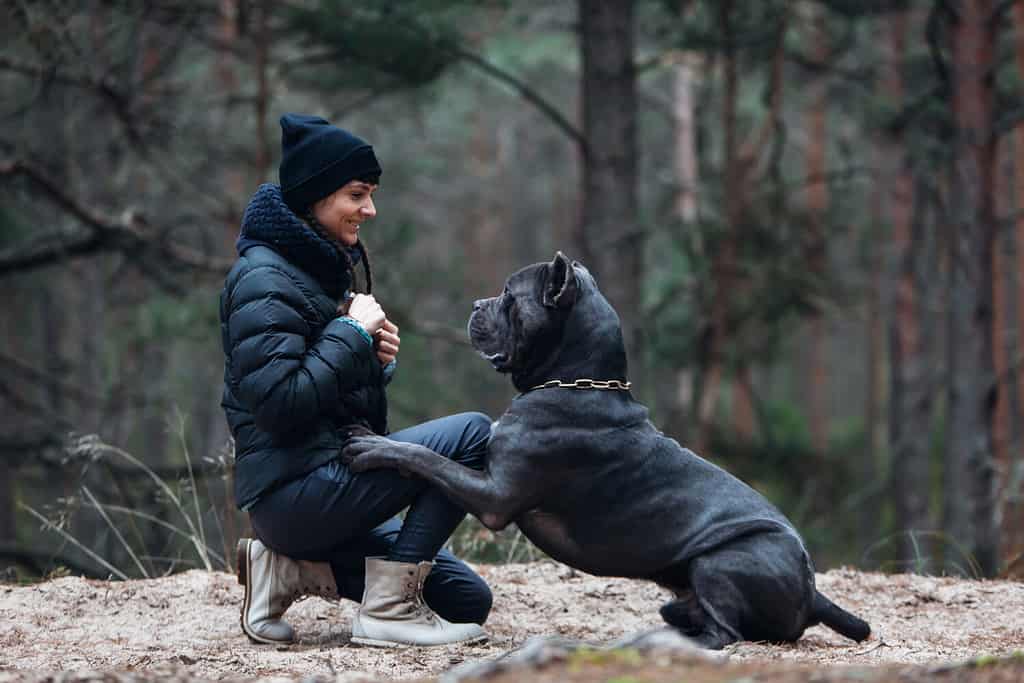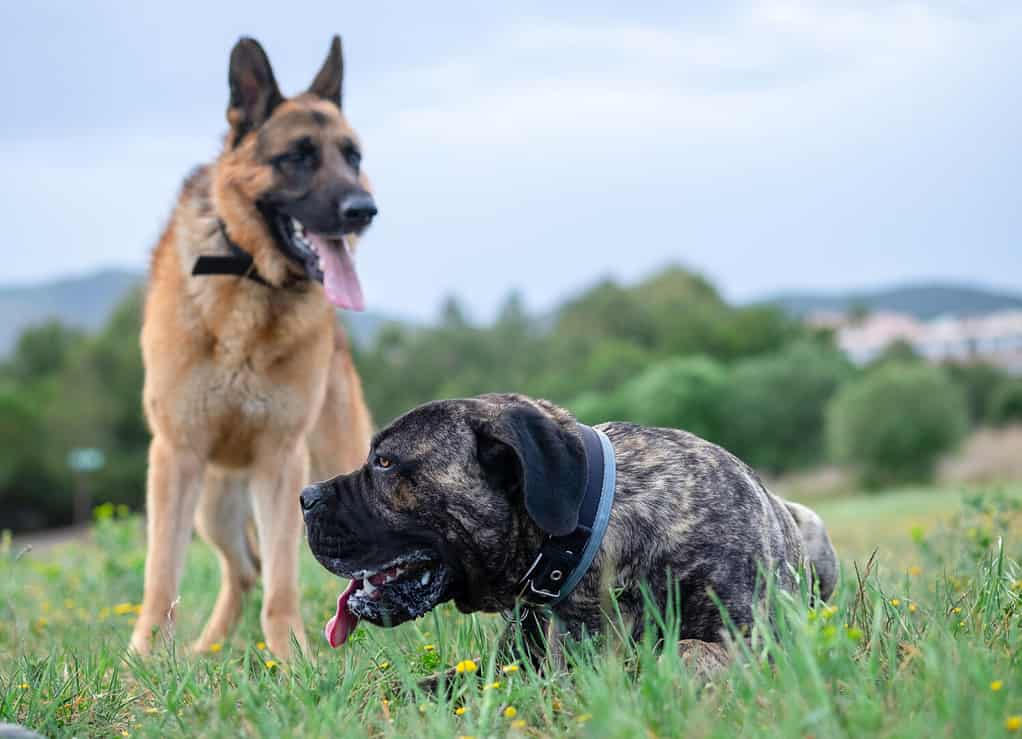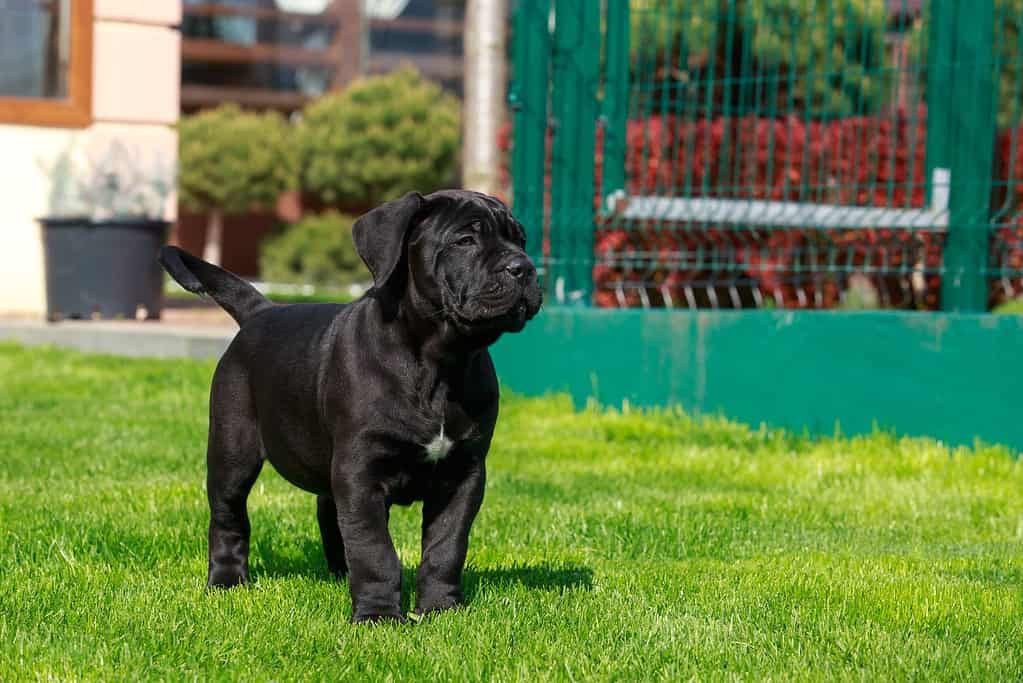While young cani corsi may seem loveable and cute, they grow into giant, powerful dogs that will need adequate training to be successful later in life. cani corsi can struggle with behavioral issues, such as anxiety, aggression, and fearfulness, when not properly trained. To help combat these problems, owners can take it upon themselves to provide early intervention and consistent training. Don’t worry if you don’t know where to start.
We can help assist you on how to train your cane corso and provide methods and tips. When it comes down to it, training a cane corso requires persistence and patience — from both you and the dog. With frequent training sessions, a cane corso can progress and learn how to control its nearly 100 lb body. So, let’s get into the training tips and tricks!
Misconceptions About the Cane Corso Breed

A common misconception about cani corsi is that the breed is a naturally aggressive dog. However, this is not true.
©Taisya Korchak/Shutterstock.com
Cani corsi are often interpreted as aggressive and assertive. However, that’s not true! While the breed is more challenging to train, they can become loyal, well-trained dogs with a dedicated owner.
Despite being guard dogs, cani corsi can be just as loyal and loving as any other breed. The main difference is that the breed requires extra care regarding obedience and training. A poorly trained cane corso can become defensive, anxious, and territorial.
So, the breed is not for the faint of heart. They need lots of attention and training, especially at the early stages.
#1 Building a Strong Bond and Trust

Strong attachments can help build trust with your dog and can help make training sessions more productive.
©BoJack/Shutterstock.com
A study found that dogs benefit from building a strong attachment bond similar to a caregiver-infant relationship. Interaction with your dog or puppy is one of the strongest methods of creating a lasting bond. It’s not enough to just simply sit in a room with your cane corso. Instead, focus on creating a positive environment that is both fun and rewarding.
No matter what the breed, it’s essential that your pet understands that you’re their safe space. That way, they can trust you in times of uncertainty instead of getting anxious or defensive. Cani corsi are loyal dogs but can become aggressive and defensive if unsure. So, creating a strong bond and trust with them will go a long way in times of uncertainty.
How to Build Trust With a Cane Corso
Building trust can seem a little confusing for any cane corso owner. Despite the challenge, there’s a handful of tips you can keep in mind to understand your cane corso. The first aspect of building trust is learning to read your cane corso’s body language. Signs of comfort are tail wagging, relaxed body and face, and willingness to interact. A cane corso that displays a tense body, growling, panting, and ears going back signals anxiety and stress.
The second trick to building trust is to go at a slow and steady pace. Your dog will give indications on whether they are comfortable. While owners should still be consistent with training, they also should be mindful of what is too much for a dog, as it can cause extra stress. A quick 15-minute session two to three times daily is a good place to start.
Lastly, do fun things! In the early bonding stages, you’ll want to do things your cane corso finds fun and rewarding. Some dogs enjoy playing fetch, tugging a war, or running around being chased. On the other hand, others might enjoy cuddling, scratches, etc. Finding what works best for your cane corso is key.
Implementing Positive Reinforcement
Positive reinforcement is a term in psychology that refers to rewarding and reinforcing a desirable behavior so that it will happen more in the future. Essentially, you’re rewarding good behavior, and your dog will be more likely to listen and perform that behavior again. Positive reinforcement is the strongest form of reinforcement and is much more helpful than teaching your dog who is “alpha” or using punishment.
To use positive reinforcement, you must find a reward your dog prefers. Some dogs may enjoy treats, while others might enjoy scratches and attention. The important thing is to choose something that your dog loves.
For example, if you’re teaching a cane corso puppy its name, you will reward it anytime it makes eye contact. You will need to repeat this process consistently to see results. Cani corsi are often quick learners, so you’ll likely see results within a few days. If the dog starts responding without needing treats, you’ve successfully trained them using positive reinforcement.
#2 Early Socialization

Socialization is crucial in reducing your dog’s anxiety and stress levels.
©PILAR G.ABADIAS/Shutterstock.com
If you get your cane corso from a breeder, then chances are they have already begun socializing the puppy. Socialization is practicing social interactions with other humans and animals in various environments. The ideal age for this is after you have bonded and built trust, so around three and fourteen weeks of age.
How to Socialize Your Cane Corso With Other Dogs and Animals
Cani corsi are very territorial regarding their home and property because they are guard dogs. While they can do well with other dogs and animals, a cane corso can become defensive when presented with a dog of the same sex.
To avoid aggression, it’s always best to introduce the cane corso to a dog of the same sex outside the home. Going to a neutral territory, such as a dog park, can help prevent the dog from feeling protective or that another dog is coming to steal its place. Practicing good habits with the other dog is essential to socializing without issues.
For other animals, it’s best to do something similar. Choose a neutral zone and then slowly introduce them to each other. Don’t try to force any interactions, and allow the animals to keep their distance. If there are signs of aggression, such as panting, growling, or barking, remove your cane corso from the area and allow them to calm down before trying again.
How to Socialize Your Cane Corso With Other People
Interaction with humans should start from the moment you bring them home. They likely already started this process if you’ve got a puppy from a breeder. If not, it’s a good time to start socializing with household members.
Socializing your cane corso puppy starts by allowing it to come into contact with other people. This means letting it walk around and sniff other household members. Once the puppy is comfortable with you and others, they can move on to meeting people outdoors or with friends.
A key component of socialization is also to take your puppy on walks. If they are young enough, they can start learning leash training and be introduced to people on the sidewalk.
How to Socialize Your Cane Corso With Children
Children can be very stressful for a cane corso, especially if the kid is younger and grabs a lot. One way to combat this is to train both the child and the dog.
For example, you will first want to get your cane corso comfortable with a kid. Once they can sniff the kid, the child can be taught how to pet the dog. If any barking, growling, or ear movements happen, it’s best to separate and try again.
It’s always best to socialize your cane corso with children. While cani corsi can be wonderful and loyal companions to children, they also can be startled easily.
#3 Crate Training

Crate training from a young age can teach a dog that they have a designated safe space in your home.
©Viktoriya Telminova/iStock via Getty Images
Crate training is optional but is highly beneficial to cani corsi. The breed struggles with separation anxiety, stress, and territorial behaviors. Creating a “safe space” where the dog can associate positive and relaxing energy is key to its well-being.
How to Crate Train
Crate training guides can be found online, but we can also provide a quick rundown. First, you’ll want to provide a big enough crate. Many owners tend to get a crate that is too big or small, which can cause a negative experience. You want a crate where your cane corso can turn around but not enough space to walk around.
Placing a blanket and some of your dog’s favorite toys can help make the crate feel less intimidating. Allow your dog to roam inside by leaving the door to the crate open for a few days, and reward them when they go inside and lie down. Over time, you can begin closing the crate door and practice leaving the room for a brief moment.
Teach your cane corso the command “crate” or “bed,” and then anytime your dog feels overwhelmed, allow them into the crate. Don’t use the crate as a form of punishment. Otherwise, the dog can associate it with a negative experience, and it will no longer be a safe place. Instead, focus on making it a fun and rewarding place.
#4 How to Desensitize Your Cane Corso

Whether outdoors or indoors, desensitization can help prevent uncertainty and help build confidence in your dog about its surroundings.
©Olga Aniven/Shutterstock.com
A commonly missed part of early training is desensitization. This term simply means that gradual exposure to an experience can allow the dog to build tolerance and reduce negative responses. For example, a cane corso can become fearful of strangers, more so than other breeds. If you train the puppy from a young age to be comfortable around strangers, they will no longer react with fear.
Desensitization to Sounds
Since the cane corso is a guard dog, they are alerted to any sound they aren’t familiar with. We’ve all seen the dog that hears the mailman and begins to bark and become overprotective of the home. A cane corso, or any dog, can be desensitized to these sounds.
Practicing producing these sounds around your cane corso can help desensitize them. For example, you can get a friend to help set down a package or box outside and walk away. This can help desensitize your dog to the sound. You can then focus on rewarding good behavior and keeping your dog calm.
Desensitization to Touch
A cane corso can become very uncomfortable with someone reaching for them without knowing. To avoid creating anxiety, it’s best to desensitize your puppy to touch from a young age. The sooner you start, the better.
You’ll want to touch their ears, paws, belly, back, etc., to help them become comfortable with the sensation. Let other people also touch them from a young age and reward them for providing a positive reaction. Over time, a young cane corso can learn to be less defensive and more relaxed.
Desensitization to Environments
New environments can be anxiety-inducing for dogs who often don’t go to new environments. From a young age, taking your dog to multiple settings, including dog parks, pet stores, play dates with other dogs, and friend’s houses, is essential. Another environment that commonly gets ignored is the car. Frequent short drives from a young age can help assist with anxiety while traveling.
Desensitization to Objects
Have you ever pulled out the vacuum cleaner, and your dog just goes insane? Well, while new objects can be scary, you can slowly adjust your dog to new things that not only come in the home but also can be found outside the house. Letting your dog sniff, touch, and put objects around the home can help them become used to them.
Some objects dogs find frightening include:
- Holiday Decor
- Children’s toys
- Tools
- Appliances
Common Mistakes Cane Corso Owners Make
After everything we’ve listed above, there are still a handful of mistakes we see owners make. It’s important to avoid these mistakes, as it can help contribute to “bad” behavior from your cane corso. So, let’s take a look at the common mistakes:
- Leaving cani corsi alone for more than four hours
- Not being patient enough with training
- Using punishment instead of positive reinforcement
- Not providing enough physical activity throughout the day
- Yelling or hitting the dog when they don’t comply
All of these result in a defensive and possibly aggressive and stressed dog. It’s important not to do any of these, especially from a young age. Even older dogs can learn to become defensive and aggressive if treated poorly. So, an owner must be on top of training their dog correctly.
How to Train Your Cane Corso Overview
As you can see, training a cane corso is similar to any breed. While they are known for their protective nature, early training can help relieve any stress the breed might harbor. So, practicing these tips and tricks can help you get their behavior on track.
While training will take longer, it’s important to stay consistent. If you feel like you can’t keep up with training or aren’t having much success, a professional dog trainer can help. A trainer will be able to identify any problems and can help demonstrate how you can train your dog more effectively.
The photo featured at the top of this post is © Natalia Fesiun/Shutterstock.com
Ready to discover the top 10 cutest dog breeds in the entire world?
How about the fastest dogs, the largest dogs and those that are -- quite frankly -- just the kindest dogs on the planet? Each day, AZ Animals sends out lists just like this to our thousands of email subscribers. And the best part? It's FREE. Join today by entering your email below.
Thank you for reading! Have some feedback for us? Contact the AZ Animals editorial team.






